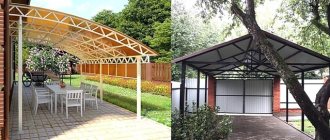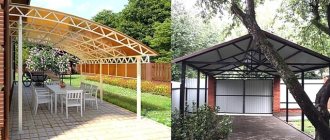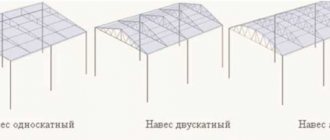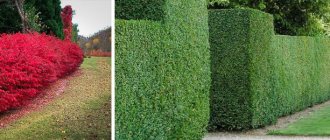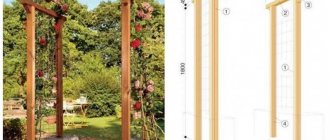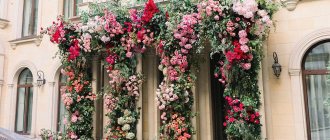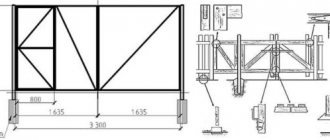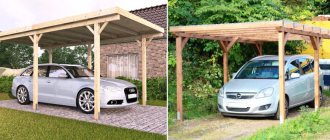It is not so easy to answer unambiguously the question of what is the best material to make a canopy in the yard, if only for the reason that you need to take into account several different factors. Including why you intend to build a shed in your yard. That is, what benefits are you going to get from this construction?
This of course does not mean that I am not going to give you specific advice on this issue. I simply suggest that you consider several of the most common options, and then draw conclusions.
What is the best material to make a canopy in the yard for practical reasons?
Currently, the choice of modern building materials is quite large. But the most popular for building a canopy are polycarbonate and metal profiles, which are often also called corrugated sheets or corrugated sheets.
These two materials have completely different characteristics, but both are successfully used for the construction of canopies.
Here we will compare them in terms of cost and operational parameters.
We just need to immediately decide by what criteria we will compare polycarbonate and metal profiles.
The most important to me are strength and durability, ease of installation, light transmission, appearance and, of course, price.
In addition, you need to take into account the material from which the canopy frame will be made.
So, let's start with polycarbonate.
Construction of the structure
Installation work is carried out in stages:
- Before making a canopy from pipes, first prepare the foundation.
- Then the materials listed in the drawing are measured and cut.
- Trusses are made.
- The side walls of the structure are assembled.
- Connect roof trusses and finished sections.
- Check the correct assembly of the elements using a level and tape measure.
- Mount and securely fasten the frame to a previously prepared area.
- Metal surfaces are treated with protective compounds.
- Prepare materials for roofing, install them and fix them.
- Trim off excess roofing.
- They restore order in the surrounding area.
When preparing the foundation for the structure, soil is removed from the places where the supports from the profile pipe will stand. A layer of crushed stone is poured onto the bottom of the dug holes. Then, in order to secure the racks, a mortgage is installed on which bolts are welded. If desired, reinforcement is used to add additional strength to the structure.
Canopy in the courtyard of a private house made of polycarbonate: pros and cons
You probably know what polycarbonate is. But let's take a quick look at its characteristics.
Polycarbonate is a polymer plastic that has a monolithic, and more often cellular or honeycomb structure.
Polycarbonate is produced in thicknesses of 4, 6, 8, 10 and 16 mm.
For canopies in private households, material with a thickness of 8-10 mm is most often used.
There is also thicker polycarbonate with a thickness of 20, 25 and 32 mm, but this is used primarily for industrial purposes.
The standard length of polycarbonate sheets is 6 or 12 meters.
Standard width is 210 mm.
Cellular polycarbonate has been known for decades, but still looks impressive and modern. Moreover, it comes in different colors, of which there are about ten.
The advantage of polycarbonate over other materials is that it allows the production of arched canopies and other, more complex shapes.
Another quality that is unique to polycarbonate is its light transmittance.
Depending on the thickness and color of the material, it is 35-98%.
True, this quality can also be a disadvantage if you live in the southern region and do not want the canopy to get too hot in the sun. In this case, you should choose the color of polycarbonate that is less translucent. Bronze-colored polycarbonate has the lowest light transmission.
But when choosing a color, keep in mind that colors such as green and blue will make your face not very pleasant to look at under the canopy. Unless of course it has any meaning to you.
The next advantage of polycarbonate is that it is lightweight and can be installed even by one person.
Another positive quality is that it is not “noisy” when it rains, unlike a metal coating.
The price of polycarbonate is quite affordable and depends mainly on the thickness of the sheet.
Above I cited the positive properties of polycarbonate as a material for making awnings in the yard. Now let's talk about his not so strong sides.
The load-bearing capacity of polycarbonate is lower than that of corrugated sheets, so to ensure the required rigidity and strength of the coating, it will be necessary to make a frame with a large number of ribs. This requires more material, usually profile pipe. And the amount of work is increasing.
The service life of polycarbonate is 10-15 years, which is half that of a metal profile.
Cellular polycarbonate fades over time in the sun. Its color becomes a little faded. Although high-quality polycarbonate has an ultraviolet coating.
It is advisable to seal the ends of polycarbonate sheets using any available method. Otherwise, water entering the honeycombs in the fall at sub-zero temperatures can destroy the material, leading to cracks.
Well, I indicated above that good light transmission of the material can be both an advantage and a disadvantage. If the canopy is not well ventilated in the summer, it will be stuffy under it.
We briefly examined the performance characteristics of a canopy made of cellular polycarbonate. Now I propose to look at several examples of ready-made polycarbonate canopies.
entrance to the house
Typically, a canopy over a porch is made solely for comfort purposes. It can also be built from wood and poles, or it can be metal and simply attached to the wall of the house.
In some cases, a budget option is a polycarbonate sheet attached to the wall with several beams. But such a canopy is not durable and can be broken in strong gusts of wind.
Usually the canopy is built together with the steps and often turns into the porch of the house.
Examples of polycarbonate canopies
In this selection of awnings, I tried to show you different options. Both for wealthy people with expensive houses, and for more modest buildings. Perhaps something will be useful to you as an example.
Canopy in the courtyard of a private house made of metal profiles: advantages and disadvantages
The second most popular material for making awnings in the yard is metal profiles or corrugated sheets, if that name is more familiar to you.
According to its purpose, corrugated sheeting is produced as wall, roofing, load-bearing and universal.
For our case, that is, for making a canopy in the yard, the optimal brands will be C20, C20K, C21, NS35 and MP. Corrugated sheeting of other brands, such as NS44, H57, H60 and H75, has a higher wavelength and is intended mainly for apartment buildings and industrial construction.
Galvanized corrugated sheets are produced in standard sheets 6 and 12 meters long.
Many manufacturers cut corrugated sheets with decorative coatings from 1.0 m in order to expand the range.
The width of metal profiles of different brands may vary. For painted ones it is 1100 mm.
Let's take a closer look at the performance characteristics of this material. As with polycarbonate, let's start with the positive qualities of the material.
An important advantage of corrugated sheeting is its higher durability. Its average service life is about 30 years, which is quite acceptable in most cases.
In addition, corrugated sheeting can withstand significantly greater loads compared to polycarbonate. If you live in a region where there is significant snow cover in winter, then this quality is essential.
The higher rigidity and strength of corrugated sheeting makes it possible to produce a canopy frame with a much smaller number of sheathing ribs compared to polycarbonate. This saves both money and time.
Laying corrugated sheets is very simple and does not require special skills.
The light weight of the sheets allows even one person to do the job.
Corrugated sheeting with decorative coating has a fairly large selection of colors, so you can easily choose what best suits the color of your house roof or fence.
A canopy made of corrugated sheets heats up significantly in the sun, but since it is not translucent, it creates a shadow. Therefore, under such a canopy it is not as hot as under a polycarbonate canopy.
The price per square meter of corrugated sheeting is slightly lower than that of polycarbonate.
The coating on corrugated sheets practically does not fade. In any case, it is not noticeable.
In what way does corrugated sheeting lose to polycarbonate?
Firstly, the corrugated sheeting makes noise in the rain.
But the main thing is that it does not allow you to build canopies of complex shapes. To lay corrugated sheeting, only a flat surface is required. For this reason, it is difficult to build something original.
Of course, you can lay corrugated sheeting in a wave along the decking, and not across it, as it should be. Then it can be bent in the same way as polycarbonate. Although this is not entirely correct from the point of view of organizing drains, if the shed is adjacent to the house. Yes, and you can use corrugated sheeting in this way only with a small comb.
Still, let's look at a few examples of canopies using corrugated sheets.
Options for canopies made of metal profiles
I said above that laying corrugated board requires a flat surface, but some interesting options are possible even in this case. So maybe this will suit your situation better.
Alternative canopy materials
We looked at two materials that are the most popular when building sheds in the yard. This is cellular polycarbonate and metal profile.
Is there an alternative to these materials?
Yes, there is, but not always the best.
The most worthy replacement for a metal profile would be metal tiles.
Its service life is just as long. And in general, in terms of technical parameters, it is close to a metal profile. And it even has some advantages. First of all, it looks more attractive on the roof than a metal profile.
The rigidity of metal tiles is slightly higher than that of metal profiles.
The snow moves off it less. This is important if you don't want it to fall on your head. But this only applies to flat canopies.
In this case, snow retainers are installed on the metal profile.
But in some ways, metal tiles are inferior to metal profiles.
Firstly, it is more troublesome to lay it. Although the work is not too difficult.
It is necessary to install transverse veins strictly at a certain distance from each other, since the metal tiles are not attached arbitrarily, but only in the recesses below the ridge.
Metal tiles are somewhat more expensive than corrugated sheets.
In general, this is a good option for building a canopy in the yard.
Are there any other options?
There are, but they are worse than the previous ones in terms of performance properties.
One of them is ondulin. Essentially the same slate, only produced using imported technology and painted in different colors.
It is lighter than domestic slate and is environmentally friendly.
This material is easy to install.
It has a reasonable price.
But ondulin also has disadvantages.
Its service life is 10-12 years.
Its paint fades and fades quite quickly.
It cannot withstand heavy snow loads compared to metal coating.
And most importantly, ondulin is flammable.
Another roofing material is the so-called soft roofing or soft tiles, as it is also called.
The ancestor of soft roofing is roofing felt. True, the performance characteristics of the new material have become significantly higher.
I will not dwell on this roofing material in great detail, but will only indicate its positive properties and disadvantages.
The advantages of this roofing material can be considered the following:
- original appearance of the roof;
- quick installation with a certain skill;
- sufficient choice of colors and shape options;
- suitable for roofs of complex shapes;
- has low weight;
- fireproof, unlike roofing felt.
The following qualities can be considered disadvantages:
- the price is higher than that of corrugated sheets or metal tiles;
- a continuous covering of boards or plywood is required, and a soft roof is laid on it;
- between the base of the roof and the soft roof, a special substrate must be laid;
- the material is not suitable for roofs with a slope of less than 12 degrees.
As you can see, there are not very many shortcomings, but they are serious. Therefore, it is worth considering before choosing this option for building a shed.
Constructive points
To facilitate the construction of a suspended structure, it is necessary to carefully review in advance the features and subtleties of the design solutions that are used during construction. All types of canopies have common components - nodes. But the difference between these elements is in the execution technique. The main 3 nodes in the structures are as follows:
- Suspension of console models, otherwise – frame or support frame. Concrete-filled or dug-in pillars, frames, and a set of fastening elements.
- Rafter system. There are different types - arched, domed, wavy, hipped, lean-to. It consists of sheathing and rafter legs, crossbars, mauerlats, tie rods, and struts.
- Roof. They are made from different materials - slate, PVC, roofing felt, metal tiles, ondulin, polycarbonate, profiled sheets. Lighter types (corrugated sheeting, etc.) are more often used to make the structure less heavy and reduce the load on the supporting part.
Large canopies must have a complex rafter system assembled from trusses with a large number of struts and supports.
Using different types of rafters, roofing materials, and supports, it is possible to create a unique structure that enhances the decorative and functional components of the local area. You can place tubs of flowers on the supports of the hanging structure or plant flowering and fruiting plants along them.
Polycarbonate carport at the dacha: the best options
It may be necessary to build a canopy not only in the courtyard, but also in the country house. For example, in order to protect the car from direct sunlight and other unfavorable factors.
For example, let's look at canopy options using polycarbonate.
There is no point in describing the technical characteristics of this material for the reason that they were discussed above.
It must be said that a carport in a country house is not fundamentally different from a carport built in a courtyard on a personal plot. The only difference may be that it may be more modest if you do not have a luxurious dacha. And therefore less expensive. Both financially and in terms of labor costs.
It is not necessary to build such a canopy on a concrete foundation. It is enough to dig metal posts into the ground.
You can generally install the canopy on a metal frame and then it can be moved if necessary. Of course, it won't be very easy, but four men can handle it.
Of course, you can make a carport not only from polycarbonate. Corrugated sheets or metal tiles are quite suitable for this. It's up to you to decide.
By the way, in many cities such canopies can be purchased ready-made, as in the photo below.
Special purpose
Self-made hanging structures can be permanent (major) or temporary (collapsible). But, both of these varieties are united by the main function - to protect a certain space, sometimes a significant one, from precipitation and sunlight. Based on their design features, canopies are conventionally divided into the following types:
- Open - several vertical supports on which a light roof made of different materials is located.
- Closed - stationary buildings with glazed openings or covered with sheets of materials that are resistant to moisture and wear.
- Semi-closed - frame buildings with a stationary roof and parapets.
Wall-mounted structures can stand alone or be supported by another structure. Awnings can play the role of canopies over a porch, gate, or gate. These structures can be used as shading for shade-loving plant crops, which enhances the originality of the landscape design of the site.
Drawing conclusions
The purpose of this article was to answer the question of what is best to make a canopy in the yard near the house or in the country. I tried to describe the advantages and disadvantages of most popular roofing materials. And you will have to draw a conclusion about which one to give preference to. For the reasons that it will depend on your financial capabilities and preferences.
But in any case, I approve of your desire to make your life more comfortable and wish you good luck in this.
Sincerely, Tkachenko Alexander.
Let's sum it up
Roofing material for a canopy should be beautiful, inexpensive, lightweight, withstand heavy weight and be mounted on a thin sheathing. It should also bend well if the roof is arched.
Considering these criteria, here is what is best to make a roof for a canopy from:
- Profiled polycarbonate is transparent, durable, easy to clean and bends.
- Profiled sheet is durable, hard, inexpensive.
- Metal tiles are the same as corrugated sheets, only more beautiful.
- Cellular polycarbonate is very cheap and transparent.
- Ondulin is flexible, cheap, and holds the load well.
